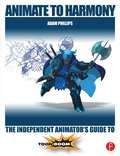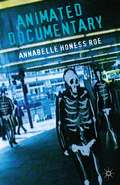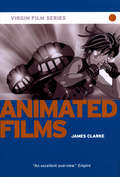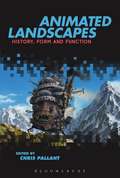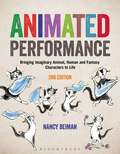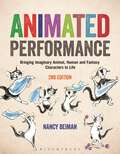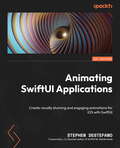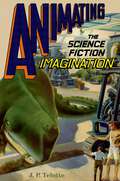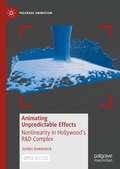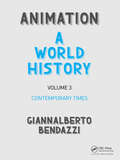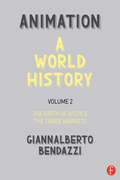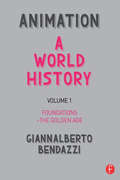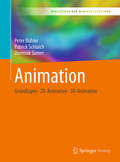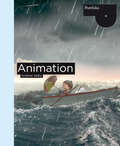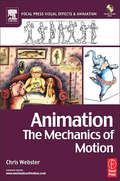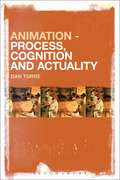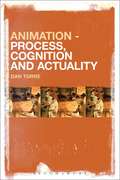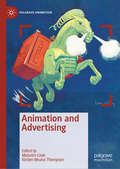- Table View
- List View
Animate to Harmony: The Independent Animator's Guide to Toon Boom
by Adam PhillipsWant to create studio-quality work and get noticed? Just coming off Flash and looking for a Toon Boom intro? Are you a traditional pencil-and-paper animator? From scene setup to the final render, learn how to navigate the Toon Boom interface to create animation that can be published on a variety of platforms and formats. Animate to Harmony guides you through Toon Boom’s Animate, Animate Pro and Harmony programs, teaching you how to create high-quality 2D animation of all complexities. The main text focuses onfeatures that are common across all three programs while "Advanced Techniques" boxes throughout the book elaborate on Pro and Harmony features, appealing to all levels of experience with any of the three main Toon Boom products.
Animate to Harmony: The Independent Animator's Guide to Toon Boom
by Adam PhillipsWant to create studio-quality work and get noticed? Just coming off Flash and looking for a Toon Boom intro? Are you a traditional pencil-and-paper animator? From scene setup to the final render, learn how to navigate the Toon Boom interface to create animation that can be published on a variety of platforms and formats. Animate to Harmony guides you through Toon Boom’s Animate, Animate Pro and Harmony programs, teaching you how to create high-quality 2D animation of all complexities. The main text focuses onfeatures that are common across all three programs while "Advanced Techniques" boxes throughout the book elaborate on Pro and Harmony features, appealing to all levels of experience with any of the three main Toon Boom products.
Animated Documentary
by Annabelle Honess RoeAnimated Documentary, the first book to be published on this fascinating topic, considers how animation is used as a representational strategy in nonfiction film and television and explores the ways animation expands the range and depth of what documentary can show us about the world.On behalf of the Society for Animation Studies(SAS), the Chair of the Jury announced the book as the winner of the delayed 2015 SAS McLaren-Lambart Award with the following words:'Animated Documentary is a vital addition to both animation scholarship and film studies scholarship more broadly, expertly achieving the tricky challenge of synthesising these two scholarly traditions to provide a compelling and brilliantly coherent account of the animated documentary form. At the heart of Roe’s book is the conviction that animated documentary “has the capacity to represent temporally, geographically, and psychologically distal aspects of life beyond the reach of live action” (p. 22). As a representational strategy, Roe details how animated documentary can be seen to adopt techniques of “mimetic substitution, non-mimetic substitution and evocation” in response to the limitations of live action material (p. 26). Animated Documentary will without doubt become an essential resource for many years to come for anyone interested in the intersection of animation and documentary.'
Animated Films - Virgin Film (Virgin Film Ser.)
by James ClarkeAnimation has never been so popular. The best animated films have combined the latest technology with creativity and a flair for storytelling and are adored by both children and adults. With films such as Monsters, Inc., Shrek and Toy Story capturing the imagination of moviegoers and critics, animated film is enjoying a resurgence unseen since its golden age in the 30s and 40s. From the earliest full-length feature animation, Disney's Snow White and the Seven Dwarfs, through stop-motion animation and Japanese anime to the advent of CGI, this book takes a critical look at animation through the ages and explores its infinite cinematic possibilities.
Animated Landscapes: History, Form and Function
by Chris PallantWinner of the 2017 McLaren-Lambart Award for Best Book on the Subject of AnimationStudying landscape in cinema isn't quite new; it'd be hard to imagine Woody Allen without New York, or the French New Wave without Paris. But the focus on live-action cinema leaves a significant gap in studying animated films. With the almost total pervasiveness of animation today, this collection provides the reader with a greater sense of how the animated landscapes of the present relate to those of the past. Including essays from international perspectives, Animated Landscapes introduces an idea that has seemed, literally, to be in the background of animation studies.The collection provides a timely counterpoint to the dominance of character (be that either animated characters such as Mickey Mouse or real world personalities such as Walt Disney) that exists within animation scholarship (and film studies more generally). Chapters address a wide range of topics including history, case studies in national contexts (including Australia, Japan, China and Latvia), the traversal of animated landscape, the animation of fantastical landscapes, and the animation of interactive landscapes. Animated Landscapes promises to be an invaluable addition to the existing literature, for the most overlooked aspect of animation.
Animated Landscapes: History, Form and Function
by Chris PallantWinner of the 2017 McLaren-Lambart Award for Best Book on the Subject of AnimationStudying landscape in cinema isn't quite new; it'd be hard to imagine Woody Allen without New York, or the French New Wave without Paris. But the focus on live-action cinema leaves a significant gap in studying animated films. With the almost total pervasiveness of animation today, this collection provides the reader with a greater sense of how the animated landscapes of the present relate to those of the past. Including essays from international perspectives, Animated Landscapes introduces an idea that has seemed, literally, to be in the background of animation studies.The collection provides a timely counterpoint to the dominance of character (be that either animated characters such as Mickey Mouse or real world personalities such as Walt Disney) that exists within animation scholarship (and film studies more generally). Chapters address a wide range of topics including history, case studies in national contexts (including Australia, Japan, China and Latvia), the traversal of animated landscape, the animation of fantastical landscapes, and the animation of interactive landscapes. Animated Landscapes promises to be an invaluable addition to the existing literature, for the most overlooked aspect of animation.
Animated Performance: Bringing Imaginary Animal, Human and Fantasy Characters to Life (Required Reading Range)
by Nancy BeimanAnimated Performance shows how a character can seemingly 'come to life' when their movements reflect the emotional or narrative context of their situation: when they start to 'perform'.The many tips, examples and exercises from a veteran of the animation industry will help readers harness the flexibility of animation to portray a limitless variety of characters and ensure that no two performances are ever alike. More than 300 color illustrations demonstrate how animal and fantasy characters can live and move without losing their non-human qualities and interviews with Disney animators Art Babbitt, Frank Thomas, Ollie Johnston and Ellen Woodbury make this a unique insight into bringing a whole world of characters to life.New to the second edition: A new chapter with introductory exercises to introduce beginner animators to the the world of animated acting; dozens of new assignments and examples focusing on designing and animating fantasy and animal characters.
Animated Performance: Bringing Imaginary Animal, Human and Fantasy Characters to Life (Required Reading Range)
by Nancy BeimanAnimated Performance shows how a character can seemingly 'come to life' when their movements reflect the emotional or narrative context of their situation: when they start to 'perform'.The many tips, examples and exercises from a veteran of the animation industry will help readers harness the flexibility of animation to portray a limitless variety of characters and ensure that no two performances are ever alike. More than 300 color illustrations demonstrate how animal and fantasy characters can live and move without losing their non-human qualities and interviews with Disney animators Art Babbitt, Frank Thomas, Ollie Johnston and Ellen Woodbury make this a unique insight into bringing a whole world of characters to life.New to the second edition: A new chapter with introductory exercises to introduce beginner animators to the the world of animated acting; dozens of new assignments and examples focusing on designing and animating fantasy and animal characters.
Animated Performance: Bringing Imaginary Animal, Human and Fantasy Characters to Life (Required Reading Range)
by Nancy BeimanAnimated Performance shows how a character can seemingly 'come to life' when their movements reflect the emotional or narrative context of their situation: when they start to 'perform'.The many tips, examples and exercises from a veteran of the animation industry will help readers harness the flexibility of animation to portray a limitless variety of characters and ensure that no two performances are ever alike. More than 300 color illustrations demonstrate how animal and fantasy characters can live and move without losing their non-human qualities and interviews with Disney animators Art Babbitt, Frank Thomas, Ollie Johnston and Ellen Woodbury make this a unique insight into bringing a whole world of characters to life.New to the second edition: A new chapter with introductory exercises to introduce beginner animators to the the world of animated acting; dozens of new assignments and examples focusing on designing and animating fantasy and animal characters.
Animating SwiftUI Applications: Create Visually Stunning And Engaging Animations For Ios With Swiftui
by Stephen DeStefanoCreate visually stunning and engaging animations for iOS with SwiftUI
ANIMATING THE SCIENCE FICTION FILM C
by J.P. TelotteLong before flying saucers, robot monsters, and alien menaces invaded our movie screens in the 1950s, there was already a significant but overlooked body of cinematic science fiction. Through analyses of early twentieth-century animations, comic strips, and advertising, Animating the Science Fiction Imagination unearths a significant body of cartoon science fiction from the pre-World War II era that appeared at approximately the same time the genre was itself struggling to find an identity, an audience, and even a name. In this book, author J.P. Telotte argues that these films helped sediment the genre's attitudes and motifs into a popular culture that found many of those ideas unsettling, even threatening. By binding those ideas into funny and entertaining narratives, these cartoons also made them both familiar and non-threatening, clearing a space for visions of the future, of other worlds, and of change that could be readily embraced in the post-war period.
Animating the Science Fiction Imagination
by J.P. TelotteLong before flying saucers, robot monsters, and alien menaces invaded our movie screens in the 1950s, there was already a significant but overlooked body of cinematic science fiction. Through analyses of early twentieth-century animations, comic strips, and advertising, Animating the Science Fiction Imagination unearths a significant body of cartoon science fiction from the pre-World War II era that appeared at approximately the same time the genre was itself struggling to find an identity, an audience, and even a name. In this book, author J.P. Telotte argues that these films helped sediment the genre's attitudes and motifs into a popular culture that found many of those ideas unsettling, even threatening. By binding those ideas into funny and entertaining narratives, these cartoons also made them both familiar and non-threatening, clearing a space for visions of the future, of other worlds, and of change that could be readily embraced in the post-war period.
Animating Unpredictable Effects: Nonlinearity in Hollywood’s R&D Complex (Palgrave Animation)
by Jordan GowanlockUncanny computer-generated animations of splashing waves, billowing smoke clouds, and characters’ flowing hair have become a ubiquitous presence on screens of all types since the 1980s. This Open Access book charts the history of these digital moving images and the software tools that make them. Unpredictable Visual Effects uncovers an institutional and industrial history that saw media industries conducting more private R&D as Cold War federal funding began to wane in the late 1980s. In this context studios and media software companies took concepts used for studying and managing unpredictable systems like markets, weather, and fluids and turned them into tools for animation. Unpredictable Visual Effects theorizes how these animations are part of a paradigm of control evident across society, while at the same time exploring what they can teach us about the relationship between making and knowing.
Animation: Volume III: Contemporary Times
by Giannalberto BendazziA continuation of 1994’s groundbreaking Cartoons, Giannalberto Bendazzi’s Animation: A World History is the largest, deepest, most comprehensive text of its kind, based on the idea that animation is an art form that deserves its own place in scholarship. Bendazzi delves beyond just Disney, offering readers glimpses into the animation of Russia, Africa, Latin America, and other often-neglected areas and introducing over fifty previously undiscovered artists. Full of first-hand, never before investigated, and elsewhere unavailable information, Animation: A World History encompasses the history of animation production on every continent over the span of three centuries. Volume III catches you up to speed on the state of animation from 1991 to present. Although characterized by such trends as economic globalization, the expansion of television series, emerging markets in countries like China and India, and the consolidation of elitist auteur animation, the story of contemporary animation is still open to interpretation. With an abundance of first-hand research and topics ranging from Nickelodeon and Pixar to modern Estonian animation, this book is the most complete record of modern animation on the market and is essential reading for all serious students of animation history. Key Features Over 200 high quality head shots and film stills to add visual reference to your research Detailed information on hundreds of never-before researched animators and films Coverage of animation from more than 90 countries and every major region of the world Chronological and geographical organization for quick access to the information you’re looking for
Animation: Volume II: The Birth of a Style - The Three Markets
by Giannalberto BendazziA continuation of 1994’s groundbreaking Cartoons, Giannalberto Bendazzi’s Animation: A World History is the largest, deepest, most comprehensive text of its kind, based on the idea that animation is an art form that deserves its own place in scholarship. Bendazzi delves beyond just Disney, offering readers glimpses into the animation of Russia, Africa, Latin America, and other often-neglected areas and introducing over fifty previously undiscovered artists. Full of first-hand, never before investigated, and elsewhere unavailable information, Animation: A World History encompasses the history of animation production on every continent over the span of three centuries. Volume II delves into the decades following the Golden Age, an uncertain time when television series were overshadowing feature films, art was heavily influenced by the Cold War, and new technologies began to emerge that threatened the traditional methods of animation. Take part in the turmoil of the 1950s through 90s as American animation began to lose its momentum and the advent of television created a global interest in the art form. With a wealth of new research, hundreds of photographs and film stills, and an easy-to-navigate organization, this book is essential reading for all serious students of animation history. Key Features Over 200 high quality head shots and film stills to add visual reference to your research Detailed information on hundreds of never-before researched animators and films Coverage of animation from more than 90 countries and every major region of the world Chronological and geographical organization for quick access to the information you’re looking for
Animation: Volume I: Foundations - The Golden Age
by Giannalberto BendazziA continuation of 1994’s groundbreaking Cartoons, Giannalberto Bendazzi’s Animation: A World History is the largest, deepest, most comprehensive text of its kind, based on the idea that animation is an art form that deserves its own place in scholarship. Bendazzi delves beyond just Disney, offering readers glimpses into the animation of Russia, Africa, Latin America, and other often-neglected areas and introducing over fifty previously undiscovered artists. Full of first-hand, never before investigated, and elsewhere unavailable information, Animation: A World History encompasses the history of animation production on every continent over the span of three centuries. Volume I traces the roots and predecessors of modern animation, the history behind Émile Cohl's Fantasmagorie, and twenty years of silent animated films. Encompassing the formative years of the art form through its Golden Age, this book accounts for animation history through 1950 and covers everything from well-known classics like Steamboat Willie to animation in Egypt and Nazi Germany. With a wealth of new research, hundreds of photographs and film stills, and an easy-to-navigate organization, this book is essential reading for all serious students of animation history. Key Features Over 200 high quality head shots and film stills to add visual reference to your research Detailed information on hundreds of never-before researched animators and films Coverage of animation from more than 90 countries and every major region of the world Chronological and geographical organization for quick access to the information you’re looking for
Animation: Volume II: The Birth of a Style - The Three Markets
by Giannalberto BendazziA continuation of 1994’s groundbreaking Cartoons, Giannalberto Bendazzi’s Animation: A World History is the largest, deepest, most comprehensive text of its kind, based on the idea that animation is an art form that deserves its own place in scholarship. Bendazzi delves beyond just Disney, offering readers glimpses into the animation of Russia, Africa, Latin America, and other often-neglected areas and introducing over fifty previously undiscovered artists. Full of first-hand, never before investigated, and elsewhere unavailable information, Animation: A World History encompasses the history of animation production on every continent over the span of three centuries. Volume II delves into the decades following the Golden Age, an uncertain time when television series were overshadowing feature films, art was heavily influenced by the Cold War, and new technologies began to emerge that threatened the traditional methods of animation. Take part in the turmoil of the 1950s through 90s as American animation began to lose its momentum and the advent of television created a global interest in the art form. With a wealth of new research, hundreds of photographs and film stills, and an easy-to-navigate organization, this book is essential reading for all serious students of animation history. Key Features Over 200 high quality head shots and film stills to add visual reference to your research Detailed information on hundreds of never-before researched animators and films Coverage of animation from more than 90 countries and every major region of the world Chronological and geographical organization for quick access to the information you’re looking for
Animation: Volume I: Foundations - The Golden Age
by Giannalberto BendazziA continuation of 1994’s groundbreaking Cartoons, Giannalberto Bendazzi’s Animation: A World History is the largest, deepest, most comprehensive text of its kind, based on the idea that animation is an art form that deserves its own place in scholarship. Bendazzi delves beyond just Disney, offering readers glimpses into the animation of Russia, Africa, Latin America, and other often-neglected areas and introducing over fifty previously undiscovered artists. Full of first-hand, never before investigated, and elsewhere unavailable information, Animation: A World History encompasses the history of animation production on every continent over the span of three centuries. Volume I traces the roots and predecessors of modern animation, the history behind Émile Cohl's Fantasmagorie, and twenty years of silent animated films. Encompassing the formative years of the art form through its Golden Age, this book accounts for animation history through 1950 and covers everything from well-known classics like Steamboat Willie to animation in Egypt and Nazi Germany. With a wealth of new research, hundreds of photographs and film stills, and an easy-to-navigate organization, this book is essential reading for all serious students of animation history. Key Features Over 200 high quality head shots and film stills to add visual reference to your research Detailed information on hundreds of never-before researched animators and films Coverage of animation from more than 90 countries and every major region of the world Chronological and geographical organization for quick access to the information you’re looking for
Animation: Volume III: Contemporary Times
by Giannalberto BendazziA continuation of 1994’s groundbreaking Cartoons, Giannalberto Bendazzi’s Animation: A World History is the largest, deepest, most comprehensive text of its kind, based on the idea that animation is an art form that deserves its own place in scholarship. Bendazzi delves beyond just Disney, offering readers glimpses into the animation of Russia, Africa, Latin America, and other often-neglected areas and introducing over fifty previously undiscovered artists. Full of first-hand, never before investigated, and elsewhere unavailable information, Animation: A World History encompasses the history of animation production on every continent over the span of three centuries. Volume III catches you up to speed on the state of animation from 1991 to present. Although characterized by such trends as economic globalization, the expansion of television series, emerging markets in countries like China and India, and the consolidation of elitist auteur animation, the story of contemporary animation is still open to interpretation. With an abundance of first-hand research and topics ranging from Nickelodeon and Pixar to modern Estonian animation, this book is the most complete record of modern animation on the market and is essential reading for all serious students of animation history. Key Features Over 200 high quality head shots and film stills to add visual reference to your research Detailed information on hundreds of never-before researched animators and films Coverage of animation from more than 90 countries and every major region of the world Chronological and geographical organization for quick access to the information you’re looking for
Animation: Grundlagen - 2D-Animation - 3D-Animation (Bibliothek der Mediengestaltung)
by Peter Bühler Patrick Schlaich Dominik SinnerDieser Band der „Bibliothek der Mediengestaltung“ behandelt die Prinzipien der Animation und führt in die grundlegenden Techniken zur Erstellung von 2D- und 3D-Animationen ein. Für diese Bibliothek wurden die Themen des Kompendiums der Mediengestaltung neu strukturiert, vollständig überarbeitet und in ein handliches Format gebracht. Leitlinien waren hierbei die Anpassung an die Entwicklungen in der Werbe- und Medienbranche sowie die Berücksichtigung der aktuellen Rahmenpläne und Studienordnungen sowie Prüfungsanforderungen der Ausbildungs- und Studiengänge.Die Bände der „Bibliothek der Mediengestaltung“ enthalten zahlreiche praxisorientierte Aufgaben mit Musterlösungen und eignen sich als Lehr- und Arbeitsbücher an Schulen und Hochschulen sowie zum Selbststudium.
Animation (Portfolio)
by Andrew SelbyFrom scriptwriting through to production, this introduction to animation for students surveys key technical processes and examines a variety of stylistic approaches. The book includes visual examples from key animators and illustrated features on how to create exciting animation for a variety of audiences.It begins with history and context, and quickly moves on to more practical aspects of the craft. Box features outline practical information and visual examples of different animators’ work and working processes teach how to create exciting animation for any audience. A final chapter on job roles shows how students can get on in animation.This book is a vital resource for anyone who intends to make animation a part of their career.
Animation: The Mechanics of Motion (Visual Effects And Animation Ser.)
by Chris WebsterLearn the key skills you need with this practical and inspirational guide to all the fundamental principles of animation. With extended pieces on timing, acting and technical aspects, Chris Webster has created the vital learning tool to help you get the most out of your animation and develop the practical skills needed by both professionals and serious students alike. The free CD-ROM includes more than 30 animations illustrating the techniques described throughout the book as well as examples of a professional Production Schedule, Budget and Production Chart - everything you need to get started! With a Foreword by Peter Lord, Creative Director and Co-Owner of Aardman Animations and an Introduction by Mike Milne, Director of the award-winning animation house Computer Animation, Framestore CFC.
Animation – Process, Cognition and Actuality
by Dan TorreAnimation - Process, Cognition and Actuality presents a uniquely philosophical and multi-disciplinary approach to the scholarly study of animation, by using the principles of process philosophy and Deleuzian film aesthetics to discuss animation practices, from early optical devices to contemporary urban design and installations. Some of the original theories presented are a process-philosophy based theory of animation; a cognitive theory of animation; a new theoretical approach to the animated documentary; an original investigative approach to animation; and unique considerations as to the convergence of animation and actuality. Numerous animated examples (from all eras and representing a wide range of techniques and approaches – including television shows and video games) are examined, such as Fantastic Mr. Fox (2009), Madame Tutli-Putli (2007), Gertie the Dinosaur (1914), The Peanuts Movie (2015), Grand Theft Auto V (2013) and Dr. Katz: Professional Therapist (1995–2000). Divided into three sections, each to build logically upon each other, Dan Torre first considers animation in terms of process and process philosophy, which allows the reader to contemplate animation in a number of unique ways. Torre then examines animation in more conceptual terms in comparing it to the processes of human cognition. This is followed by an exploration of some of the ways in which we might interpret or 'read' particular aspects of animation, such as animated performance, stop-motion, anthropomorphism, video games, and various hybrid forms of animation.He finishes by guiding the discussion of animation back to the more tangible and concrete as it considers animation within the context of the actual world. With a genuinely distinctive approach to the study of animation, Torre offers fresh philosophical and practical insights that prompt an engagement with the definitions and dynamics of the form, and its current literature.
Animation – Process, Cognition and Actuality
by Dan TorreAnimation - Process, Cognition and Actuality presents a uniquely philosophical and multi-disciplinary approach to the scholarly study of animation, by using the principles of process philosophy and Deleuzian film aesthetics to discuss animation practices, from early optical devices to contemporary urban design and installations. Some of the original theories presented are a process-philosophy based theory of animation; a cognitive theory of animation; a new theoretical approach to the animated documentary; an original investigative approach to animation; and unique considerations as to the convergence of animation and actuality. Numerous animated examples (from all eras and representing a wide range of techniques and approaches – including television shows and video games) are examined, such as Fantastic Mr. Fox (2009), Madame Tutli-Putli (2007), Gertie the Dinosaur (1914), The Peanuts Movie (2015), Grand Theft Auto V (2013) and Dr. Katz: Professional Therapist (1995–2000). Divided into three sections, each to build logically upon each other, Dan Torre first considers animation in terms of process and process philosophy, which allows the reader to contemplate animation in a number of unique ways. Torre then examines animation in more conceptual terms in comparing it to the processes of human cognition. This is followed by an exploration of some of the ways in which we might interpret or 'read' particular aspects of animation, such as animated performance, stop-motion, anthropomorphism, video games, and various hybrid forms of animation.He finishes by guiding the discussion of animation back to the more tangible and concrete as it considers animation within the context of the actual world. With a genuinely distinctive approach to the study of animation, Torre offers fresh philosophical and practical insights that prompt an engagement with the definitions and dynamics of the form, and its current literature.
Animation and Advertising (Palgrave Animation)
by Malcolm Cook Kirsten Moana ThompsonThroughout its history, animation has been fundamentally shaped by its application to promotion and marketing, with animation playing a vital role in advertising history. In individual case study chapters this book addresses, among others, the role of promotion and advertising for anime, Disney, MTV, Lotte Reiniger, Pixar and George Pal, and highlights American, Indian, Japanese, and European examples. This collection reviews the history of famous animation studios and artists, and rediscovers overlooked ones. It situates animated advertising within the context of a diverse intermedial and multi-platform media environment, influenced by print, radio and digital practices, and expanding beyond cinema and television screens into the workplace, theme park, trade expo and urban environment. It reveals the part that animation has played in shaping our consumption of particular brands and commodities, and assesses the ways in which animated advertising has both changed and been changed by the technologies and media that supported it, including digital production and distribution in the present day. Challenging the traditional privileging of art or entertainment over commercial animation, Animation and Advertising establishes a new and rich field of research, and raises many new questions concerning particular animation and media histories, and our methods for researching them.
